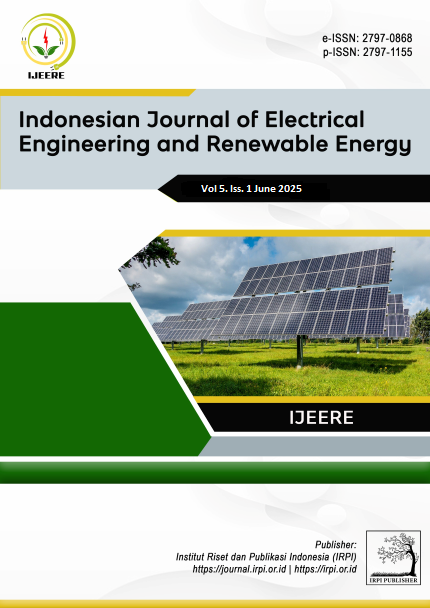Effect of Raw Material Variations on the C/N Ratio of Biogas Potential Mixtures of Chicken Manure and Water Hyacinth
Pengaruh Variasi Bahan Baku Terhadap Rasio C/N dari Potensi Biogas Campuran Kotoran ayam dan Eceng Gondok
Keywords:
Biogas, Chicken Manure, Water Hyacinth, Starter, Electrical Energy, C/N RatioAbstract
This study aims to determine the optimal C/N (carbon/nitrogen) ratio of a mixture of chicken manure and water hyacinth in the anaerobic fermentation process, as well as to evaluate the potential for biogas and electricity production with and without the use of a starter. In this experiment, a mixture of 300 kg of chicken manure and 200 kg of water hyacinth, with an additional 75 kg of starter, was used to achieve a more ideal C/N ratio. The fermentation process was carried out in two scenarios: one with a starter and one without a starter, to compare the results. The analysis results show that the use of a starter significantly increased the volume of biogas produced, which was 89.06 m³, compared to 70 m³ produced without a starter. In addition, the potential for electricity generation also increased significantly, from 329 kWh without a starter to 418 kWh with a starter. The biogas production increased by 27.23% with the use of a starter. These findings suggest that the use of a starter not only increases the volume of biogas but also improves energy conversion efficiency, making it an effective method to enhance anaerobic fermentation outcomes and achieve a more ideal C/N ratio, which in turn can optimize renewable energy production from organic materials.
References
Bapeda, “Application of Biogas Technology as an Alternative Energy Source - Bappeda Grobogan Regency.” Accessed: Jun. 30, 2024. [Online]. Available: https://bappeda.grobogan.go.id/ dokumen/kajian-dan-penelitian/56-penerapan-teknologi-biogas-sebagai-sumber-energi-alternatif
Yano Hurung Anoi, “The Effect of Variation in Feces Types on Biogas Productivity,” J. Juara , vol. 2, no. 1, pp. 2798–3315, 2022.
ATNK Maris Kurniawati, “Development of portable anaerobic biodigester producing biogas from chicken manure waste,” J. Farmer Science. , vol. 9, no. 2, pp. 95–99, 2021.
HSTMIS Hidyatullah, “The Influence of C/N Ratio Variation on the Volume of Biogas Production from Chicken Manure,” Din. Tek. Mesin , vol. 6, no. 2, pp. 1–19, 2019.
WDN Galih Munkar, Syafrudin, “The Effect of C/N Ratio on Biogas Production from Water Hyacinth Leaves Using the Liquid Anaerobic Digestion (L-Ad) Method,” J. Tek. En. , vol. 6, no. 3, pp. 1–8, 2017.
S. Dodik Luthfianto, Edwi MahaJoeno, “The effect of organic waste types and dilution on biogas production from chicken farm waste biomass,” Biotechnology , vol. 9, no. 1, pp. 18–25, 2012, doi: 10.13057/biotek/c090104.
SS Syukran Immo, Hans Tumaliang, “Case study of ‘“Using Water Hyacinth as an Alternative Energy,”’” Syukran Immo Hans Tumaliang, Sartje Silimang , p. 12, 2019.
N. Astuti, “POTENCY OF WATER HYATT (Eichhornia crassipes (Mart.) Solms) RAWAPENING FOR BIOGAS WITH VARIATIONS OF COW DUNG MIXTURES,” J. Tech. Time , 2013.
MR Haider, Zeshan, S. Yousaf, RN Malik, and C. Visvanathan, “Effect of mixing ratio of food waste and rice husk co-digestion and substrate to inoculum ratio on biogas production,” Bioresour. Technol. , vol. 190, pp. 451–457, 2015, doi: 10.1016/j.biortech.2015.02.105.
author Hanindito Andhika Budianto, “Comparison of the potential of inoculum of cow rumen fluid with cow feces in processing fecal sludge into methane gas = Comparison of the potential of inoculum of cow rumen fluid with cow feces in processing fecal sludge into methane gas.” Faculty of Engineering, University of Indonesia, 2016. Accessed: Jun. 30, 2024. [Online]. Available: https://lib.ui.ac.id
ST Rr. Dewi Artanti, “Journal of Renewable Natural Materials,” J. Renewable Natural Materials , vol. 4, no. 1, pp. 14–20, 2015, doi: 10.15294/jbat.v4i1.3769.
Y. Lukhi Mulia, Masreza Hari Darmawan, “Biogas Production from Cow Manure with Continuous and Batch Biodigesters: A Review,” J. Chem. Process Eng. , vol. 7, no. 2, pp. 85–90, 2022, doi: 10.33536/jcpe.v7i2.903.
HA Elida Novita, Sri Wahyuningsi, “Variation of Anaerobic Process Input Composition for Biogas Production in Coffee Liquid Waste Treatment,” J. Agroteknologi , vol. 12, no. 01, p. 43, 2018, doi: 10.19184/j-agt.v12i1.7887.
WGA Michael Candra Santoso, IAD Giriantar, “Study of Livestock Manure Utilization for Biogas Power Plants in Bali,” J. SPEKTRUM , vol. 6, no. 4, p. 58, 2019, doi: 10.24843/spektrum.2019.v06.i04.p9.
Nikmatul Ulfa, “The Effect of Providing Fermented Chicken Manure as a Substitute for Commercial Feed on the Growth Rate of Consumption and Feed Conversion of Male Broiler Chickens”.
Y. Eni Budiyati, Nia Fitria, “Comparison of Biogas Volume Produced from Fermentation of Water Hyacinth and Vegetable Waste Mixture with and Without Chicken Manure at Various Dilution Ratios and Times,” Teknoin , no. July, pp. 1–23, 2016.
MJ Adriyan Wahyudi, “Analysis of Potential Electrical Energy and Cost of Rumen Waste from Cows at Pekanbaru City Slaughterhouse,” JTEV (Journal of Electrical and Vocational Technology) , vol. 8, no. 2, p. 263, 2022, doi: 10.24036/jtev.v8i2.117622.
North BPTPS, “Composition of Water Hyacinth,” pp. 1–14, 2022.
MA Agum Bagas Pranindar, Umi Kusumastuti, “The effect of the dose of cow rumen compost and NPK fertilizer on the growth and yield of long beans (Vigna sinensis),” J. Agromast , vol. 2, no. 2, 2017.
Y. Yahya, T. Tamrin, and S. Triyono, “BIOGAS PRODUCTION FROM A MIXTURE OF CHICKEN MANURE, COW MANURE, AND MINI ELEPHANT GRASS (Pennisetum Purpureum cv. Mott) WITH A BATCH SYSTEM,” J. Tek. Pertan. Lampung (Journal Agric. Eng. , vol. 6, no. 3, p. 151, 2018, doi: 10.23960/jtep-l.v6i3.151-160.
S. Mujdalipah et al. , “Effect of Fermentation Time on Biogas Production Using Two-Stage Digester at Various Concentrations of Palm Oil-Mill Effluent and Activated Sludge,” J. AGRITECH , vol. 34, no. 1, pp. 56–64, 2014.
K. Rajagukguk, “Processing of Tofu Liquid Waste into Biogas Using a Portable Biogas Reactor,” Quantum Tech. J. Tech. Applied Machine. , vol. 1, no. 2, pp. 63–71, 2020, doi: 10.18196/jqt.010210.
Downloads
Published
How to Cite
Issue
Section
License
Copyright (c) 2025 Sahrur Ramadan

This work is licensed under a Creative Commons Attribution-ShareAlike 4.0 International License.




















